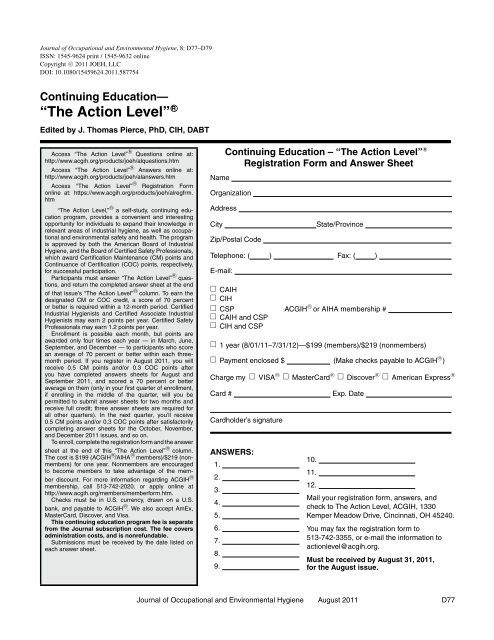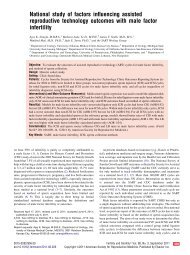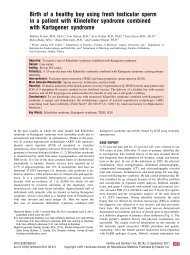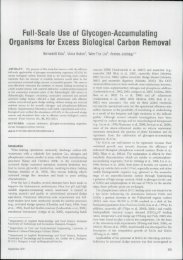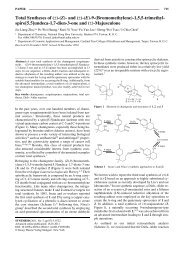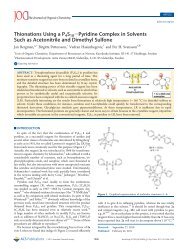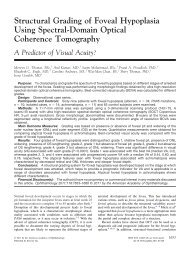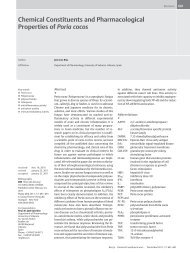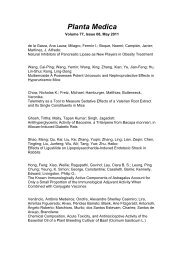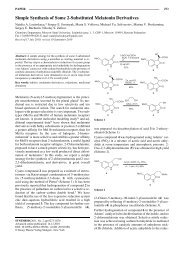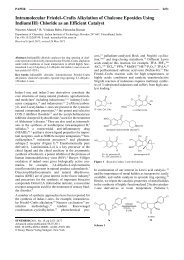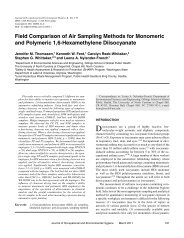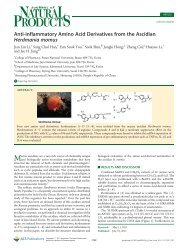“The Action Level”R
“The Action Level”R
“The Action Level”R
You also want an ePaper? Increase the reach of your titles
YUMPU automatically turns print PDFs into web optimized ePapers that Google loves.
Journal of Occupational and Environmental Hygiene, 8: D77–D79<br />
ISSN: 1545-9624 print / 1545-9632 online<br />
Copyright c○ 2011 JOEH, LLC<br />
DOI: 10.1080/15459624.2011.587754<br />
Continuing Education—<br />
<strong>“The</strong> <strong>Action</strong> Level” ○R<br />
Edited by J. Thomas Pierce, PhD, CIH, DABT<br />
Access <strong>“The</strong> <strong>Action</strong> Level” ○R Questions online at:<br />
http://www.acgih.org/products/joeh/alquestions.htm<br />
Access <strong>“The</strong> <strong>Action</strong> Level” ○R Answers online at:<br />
http://www.acgih.org/products/joeh/alanswers.htm<br />
Access <strong>“The</strong> <strong>Action</strong> Level” ○R Registration Form<br />
online at: https://www.acgih.org/products/joeh/alregfrm.<br />
htm<br />
<strong>“The</strong> <strong>Action</strong> Level,” ○R a self-study, continuing education<br />
program, provides a convenient and interesting<br />
opportunity for individuals to expand their knowledge in<br />
relevant areas of industrial hygiene, as well as occupational<br />
and environmental safety and health. The program<br />
is approved by both the American Board of Industrial<br />
Hygiene, and the Board of Certified Safety Professionals,<br />
which award Certification Maintenance (CM) points and<br />
Continuance of Certification (COC) points, respectively,<br />
for successful participation.<br />
Participants must answer <strong>“The</strong> <strong>Action</strong> Level” ○R questions,<br />
and return the completed answer sheet at the end<br />
of that issue’s <strong>“The</strong> <strong>Action</strong> Level” ○R column. To earn the<br />
designated CM or COC credit, a score of 70 percent<br />
or better is required within a 12-month period. Certified<br />
Industrial Hygienists and Certified Associate Industrial<br />
Hygienists may earn 2 points per year. Certified Safety<br />
Professionals may earn 1.2 points per year.<br />
Enrollment is possible each month, but points are<br />
awarded only four times each year — in March, June,<br />
September, and December — to participants who score<br />
an average of 70 percent or better within each threemonth<br />
period. If you register in August 2011, you will<br />
receive 0.5 CM points and/or 0.3 COC points after<br />
you have completed answers sheets for August and<br />
September 2011, and scored a 70 percent or better<br />
average on them (only in your first quarter of enrollment,<br />
if enrolling in the middle of the quarter, will you be<br />
permitted to submit answer sheets for two months and<br />
receive full credit; three answer sheets are required for<br />
all other quarters). In the next quarter, you’ll receive<br />
0.5 CM points and/or 0.3 COC points after satisfactorily<br />
completing answer sheets for the October, November,<br />
and December 2011 issues, and so on.<br />
To enroll, complete the registration form and the answer<br />
sheet at the end of this <strong>“The</strong> <strong>Action</strong> Level” ○R column.<br />
The cost is $199 (ACGIH ○R /AIHA ○R members)/$219 (nonmembers)<br />
for one year. Nonmembers are encouraged<br />
to become members to take advantage of the member<br />
discount. For more information regarding ACGIH ○R<br />
membership, call 513-742-2020, or apply online at<br />
http://www.acgih.org/members/memberform.htm.<br />
Checks must be in U.S. currency, drawn on a U.S.<br />
bank, and payable to ACGIH ○R . We also accept AmEx,<br />
MasterCard, Discover, and Visa.<br />
This continuing education program fee is separate<br />
from the Journal subscription cost. The fee covers<br />
administration costs, and is nonrefundable.<br />
Submissions must be received by the date listed on<br />
each answer sheet.<br />
Name<br />
Continuing Education – <strong>“The</strong> <strong>Action</strong> Level” ○R<br />
Registration Form and Answer Sheet<br />
Organization<br />
Address<br />
City State/Province<br />
Zip/Postal Code<br />
Telephone: ( ) Fax: ( )<br />
E-mail:<br />
CAIH<br />
CIH<br />
CSP ACGIH ○R<br />
or AIHA membership #<br />
CAIH and CSP<br />
CIH and CSP<br />
1 year (8/01/11–7/31/12)—$199 (members)/$219 (nonmembers)<br />
Payment enclosed $ (Make checks payable to ACGIH ○R<br />
)<br />
Charge my VISA ○R MasterCard ○R Discover ○R American Express ○R<br />
Card # Exp. Date<br />
Cardholder’s signature<br />
ANSWERS:<br />
1.<br />
2.<br />
3.<br />
4.<br />
5.<br />
6.<br />
7.<br />
8.<br />
9.<br />
10.<br />
11.<br />
12.<br />
Mail your registration form, answers, and<br />
check to The <strong>Action</strong> Level, ACGIH, 1330<br />
Kemper Meadow Drive, Cincinnati, OH 45240.<br />
You may fax the registration form to<br />
513-742-3355, or e-mail the information to<br />
actionlevel@acgih.org.<br />
Must be received by August 31, 2011,<br />
for the August issue.<br />
Journal of Occupational and Environmental Hygiene August 2011 D77
Continuing Education –<br />
<strong>“The</strong> <strong>Action</strong> Level” ○R<br />
QUESTIONS 8(5)<br />
Effects of Forearm vs. Leg Submersion in Work<br />
Tolerance Time in a Hot Environment While Wearing<br />
Firefighter Protective Clothing<br />
Charles P. Katica, Robert C. Pritchett, Kelly L. Pritchett, Andrew<br />
T. Del Pozzi, Gytis Balilionis, and Tim Burnham<br />
1. In the article, the average WBGT temperature of the<br />
environmental chamber was .<br />
a. ∼ 30.8 ± 0.7 ◦ C<br />
b. ∼ 35.2 ± 0.8 ◦ C<br />
c. ∼ 32.8 ± 0.9 ◦ C<br />
d. ∼ 37.2 ± 0.8 ◦ C<br />
2. In the article, the overall findings found an increase of<br />
following lower leg submersion in cool water.<br />
a. 18%<br />
b. 22%<br />
c. 24%<br />
d. 28%<br />
Evaluation of Sampling Methods for Measuring Exposure<br />
to Volatile Inorganic Acids in Workplace Air.<br />
Part 1: Sampling Hydrochloric Acid (HCL) and Nitric<br />
Acid (HNO3) from a Test Gas Atmosphere<br />
Alan Howe, Darren Musgrove, Dietmar Breuer, Krista Gusbeth,<br />
Andreas Moritz, Martine Demange, Véronique Oury, Davy<br />
Rousset, and Michel Dorotte<br />
3. When volatile acids such as hydrochloric acid and<br />
nitric acid are sampled using a sodium carbonateimpregnated<br />
quartz fiber filter and a prefilter, more<br />
reliable estimates of exposure are obtained than when<br />
the acids are sampled using a silica gel sorbent tube.<br />
This is because volatile acids can be present in the<br />
air in the form of both mist and vapor and, while filter<br />
sampling methods typically collect the inhalable fraction<br />
of airborne particles, silica gel tubes significantly undersample<br />
acid mist droplets. True or False?<br />
4. Measurement of exposure to volatile acids can be<br />
subject to both positive and negative interference, even<br />
if a prefilter is used, potentially leading to high or low<br />
results. True or False?<br />
Implementation of a Quantitative Real-Time PCR<br />
Assay for the Detection of Mycobacterium immunogenum<br />
in Metalworking Fluids<br />
Glenn Rhodes, Alexandra Fluri, Andrea Ruefenacht, Marco<br />
Gerber, and Roger Pickup<br />
5. Quantitative real-time PCR assays detect .<br />
a. DNA<br />
b. antigens<br />
c. RNA<br />
d. enzymes<br />
6. The term “cell equivalents” (CE) is used because<br />
obtaining accurate cell counts of mycobacteria is difficult<br />
due to what physiological feature?<br />
a. slow growth<br />
b. rapid growth<br />
c. cell clumping<br />
d. low cell densities<br />
Personal PM2.5 Exposure Among Wildland Firefighters<br />
Working at Prescribed Forest Burns in Southeastern<br />
United States<br />
Olorunfemi Adetona, Kevin Dunn, Dan Hall, Gary Achtemeier,<br />
Allison Stock, and Luke P. Naeher<br />
7. and are the chief occupational<br />
woodsmoke inhalation exposures for wildland<br />
firefighters.<br />
a. Volatile organic compounds; carbon dioxide<br />
b. Carbon monoxide; respirable particulate matter<br />
c. Nitrogen oxides; ozone<br />
d. Lead; benzene<br />
8. Factors that may limit the utility of using carbon monoxide<br />
as a proxy for respirable particulate matter exposure in<br />
smoke from forest fires for wildland firefighters include:<br />
a. Job task/location (i.e., working fire line on foot, driving<br />
bulldozer, flying helicopter).<br />
b. Exposure to emissions from trucks, mules (4wheelers),<br />
and other vehicles used for managing and<br />
fighting forest fires.<br />
c. Time and location of sampling (i.e., sampling firefighters<br />
at base camp for overnight exposures vs. sampling<br />
firefighters at fire line during working/fighting<br />
forest fires).<br />
d. All of the above<br />
Ice Cooling Vest on Tolerance for Exercise Under<br />
Uncompensable Heat Stress<br />
Glen P. Kenny, Andrew R. Schissler, Jill Stapleton, Matthew<br />
Piamonte, Konrad Binder, Aaron Lynn, Christopher Q. Lan,<br />
and Stephen Hardcastle<br />
9. Aging is associated with a progressive decrease in the<br />
physical work capacity and reductions in the capacity to<br />
dissipate heat. Using a cooling vest would likely reduce<br />
the level of thermal and cardiovascular strain to the<br />
same extent, therefore resulting in a similar exposure<br />
time in an older worker compared with a younger worker<br />
performing a similar intensity work protocol. True or<br />
False?<br />
10. An ice cooling vest worn under the protective garment<br />
was shown to increase exercise duration by ∼12%<br />
compared with the protective garment-only condition, yet<br />
D78 Journal of Occupational and Environmental Hygiene August 2011
the level of cardiovascular strain (as measured by heart<br />
rate) at the end of the exercise was similar. This is likely<br />
due to a greater sweat-induced reduction in central blood<br />
volume associated with the longer duration of exercise<br />
performed with the ice vest under the protective garment.<br />
True or False?<br />
Validation of the Criteria for Initiating the Cleaning<br />
of Heating, Ventilation, and Air-Conditioning (HVAC)<br />
Ductwork Under Real Conditions<br />
Jacques Lavoie, Geneviève Marchand, Yves Cloutier, and<br />
Jérôme Lavoué<br />
11. Which country does not have criteria for initiating cleaning<br />
of nonporous ductwork?<br />
a. France<br />
b. Finland<br />
c. Great Britain<br />
d. United States<br />
12. Under real conditions, which sampling method(s) of the<br />
surface dust in the duct yield(s) the most accurate results<br />
and the smallest standard deviation?<br />
a. NADCA method<br />
b. IRSST method<br />
c. ASPEC method<br />
d. NADCA and IRSST methods<br />
Answers to the August 2011 <strong>“The</strong> <strong>Action</strong> Level” ○R<br />
Questions will be available on-line (www.acgih.org/<br />
Products) on September 9, 2011.<br />
Journal of Occupational and Environmental Hygiene August 2011 D79


